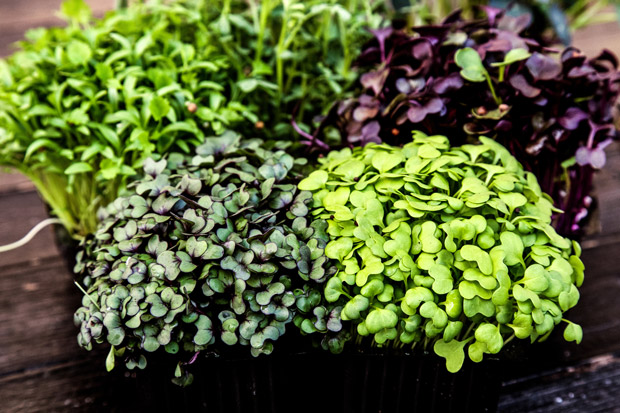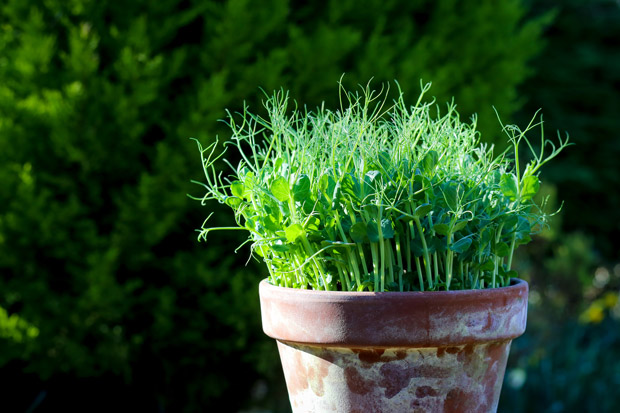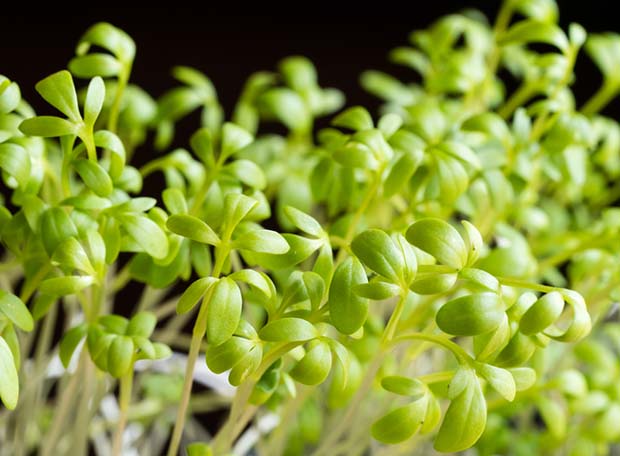8 must-try microgreens

There isn’t anything else you could grow this easily or this quickly that tastes this good and is so nutritious.
Words: Jenny Somervell
About this time of year I start dreaming of spring. Colourful seed catalogues feed my fantasies of Eden-like gardens lush with sumptuous fruit and not a bug in sight. Absence definitely makes the imagination selective.
In August, this far south at least, the ground is still cold, wet and decidedly dormant. But in the greenhouse I’ve grown a grid of microgreens, protected from the hail and southerlies.
My back-up plan worked too, so our windowsills are freshly decorated with containers of radish, beetroot, rocket, various brassicas, dill, chervil and fennel… or they were until the cook scalped them. He was initially sceptical, but is now cutting and munching fresh greens with gusto and looking for more.
With a little experimentation you will find your own favourite cool weather microgreens, many of which can be grown on to larger size if desired. Here are a few of our favourites to get you started.
Why should you grow and eat microgreens?
Microgreens are tiny vegetable greens consisting of a single central stem with fully-developed seed leaves and small, partially developed true leaves. They are cut just above soil level and used to enhance the taste, health and freshness of food in gourmet restaurants. They are highly nutritious and contain health-promoting and disease preventing properties.
1. Mustards
Mustard has been cultivated for over 5000 years for its seed and leaf. The annual black mustard (Brassica nigra) is traditionally grown for its seeds which are used as a spice, but can also be grown in the garden as a salad or stir-fry green. Studies show the antioxidant content can reduce the rate of bladder, colon and lung cancers.
Varieties to try: Brassica juncea Mustard Streaks is my favourite mustard microgreen and very flexible. It is easily grown and likes it on the cool side, but will also grow fine in the heat, germinating readily from 10-20°C.
The lacy, lime-green leaves have a sweet, hot mustard flavour. They can be harvested at microgreen stage, or as baby salad greens. I add seed to my mesclun mix to give a hot peppery accent to the milder tasting greens. You can also grow it separately and use it to spice up any salad.
Mizuna is the Japanese name for two species of mustard greens, Brassica juncea and B. rapa, grown extensively in Japan. While there are more exciting greens for summer use, mizuna is excellent for bulking up in the cooler months as it is one of the fastest-growing greens under cold conditions. I like Red Coral which has a blush of burgundy and a sweet, fresh mustard taste.
2. PEA

Pea shoots are sweet, crisp, crunchy, and taste delicious, like young snow peas. Germination is enhanced by presoaking for up to 24 hours. Grow at high density and harvest at about 5cm, or cut higher in the stem to grow on.
The shoots give an exotic touch to salads, cooked dishes, and meats. They contain protein, carbohydrate and vitamin C, vitamin B1, iron, niacin, magnesium, and zinc. Perhaps the birds know this too – they love them! I planted mine well inside the greenhouse – use cloche cover protection if they are outdoors.
Variety to try:
Fuji Feathers is my favourite and it’s intriguing, with less leaf and long, fine, feathered green tendrils, even on young seedlings. It’s quick-growing and fun for kids.
3. RADISH
Radishes (Raphanus sativus) are great microgreens to start with as they germinate quickly in cool or warm conditions and grow vigorously to harvest in 8-10 days.
They are usually picked at cotyledon (true leaf ) stage when they are tender, crisp and spicy. Use to add colour and bite to salads, and as an attractive garnish. Past cotyledon stage, plants can become woody and hot. Older shoots can be added to soups and stocks.
Radishes, especially the coloured leaf varieties, are high in vitamins, minerals and antioxidants, ranking with broccoli as a health-giving food, especially in cancer prevention.
Varieties to try: You can grow any radish variety as a microgreen but Rambo is my favourite with its deep purplish-red coloured seed leaves (the true leaves tend to green up). For an extra hot after-blast of flavour, try the east Asian white radish Daikon (Raphanus sativus var. longipinnatus).
4. Broccoli
Broccoli (Brassica oleracea) may not sound like the most exciting microgreen but for health reasons alone it is worth including. Broccoli is hailed as a superfood, high in iron, minerals, Vitamins A and C and, like radish and mustard, contains sulphoraphene which is linked to cancer prevention. Studies at John Hopkins University show that a couple of ounces a day will elevate the body’s protective enzymes.
Broccoli is one of the easiest microgreens to grow, germinating readily from 10-25°C. Sow thickly for heavy yields. Like radish, broccoli greens are best cut young at the true leaf stage, and high in the stem.
5. ROCKET
Rocket or arugula (Eruca sativa) is a native to the Mediterranean region, and a popular salad herb since Roman times. It adds a sharp, piquant spice which enlivens other milder greens. It’s also a great option for autumn/winter sowing, germinating as low as 5°C and growing faster in cool weather.
The lush green foliage can rot if it is too dense and the fragile stems can fall over with overhead watering. They also bruise easily so harvest and wash them carefully.
6. CRESS

Lepidium sativum is a good microgreen for beginners and one of the oldest. It’s so easy, I remember growing it on wet blotting paper at school, but the tiny seedlings are very small and bruise easily.
Cress is related to mustard and watercress, which it combines well with, and has the same piquant, peppery flavour. Try using cress in a herb butter or the traditional mix with mayonnaise, egg, and lashings of black pepper served in sandwiches.
7. BEETROOT
Young beet seedlings take longer to produce edible microgreens but are worth growing for the intense red colour they add to a salad mix, and their slightly earthy flavour, rather like the root.
Seeds need to be sown quite thickly. They contain an inhibitor so germination is improved by pre-soaking the seed and keeping the seedbed evenly moist until emergence, usually 10-12 days.
Variety to try: I like Bull’s Blood because it produces dark red leaves even under low light. The bright red stems are a feature too, so cut them close to the soil.
8. MESCLUN
If you can’t be bothered growing individual varieties, you can mix your favourite seed, or buy a commercial mesclun mix. I do both, using mesclun as my standard bulk greens and add other varieties for different flavour and colour effects.
Varieties to try: I use Kings Seeds’ Original Mesclun mix which contains endive, corn salad, rocket, chicory, lettuces, spinach, pak choi, beets, and mustard, then spice it up by adding Mustard Streaks, Radish Rambo and Mizuna Red Coral for extra colour.
 This article first appeared in NZ Lifestyle Block Magazine.
This article first appeared in NZ Lifestyle Block Magazine.

